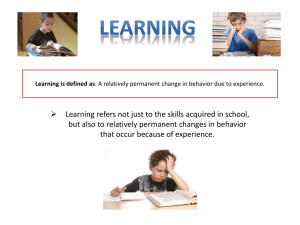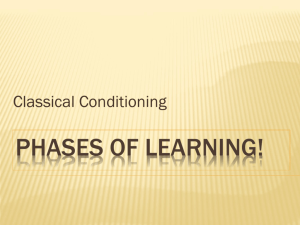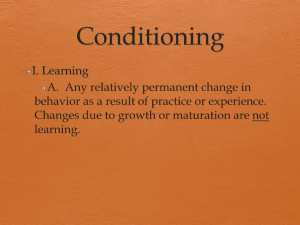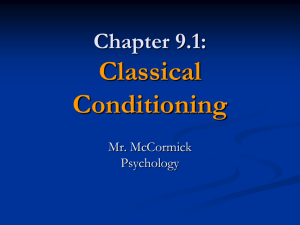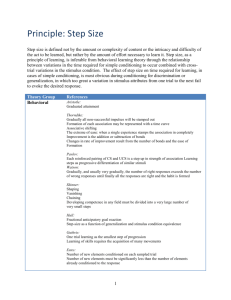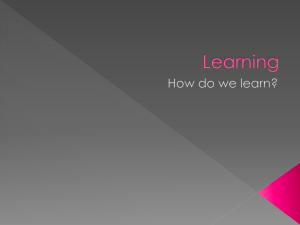02152012_Learning
advertisement
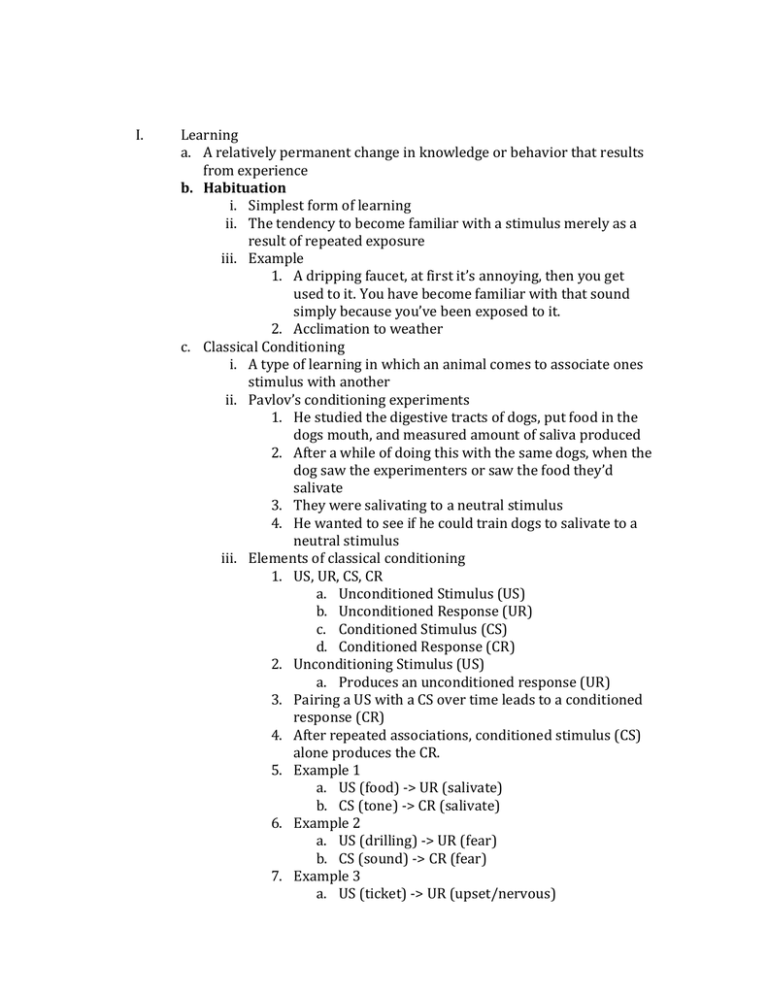
I. Learning a. A relatively permanent change in knowledge or behavior that results from experience b. Habituation i. Simplest form of learning ii. The tendency to become familiar with a stimulus merely as a result of repeated exposure iii. Example 1. A dripping faucet, at first it’s annoying, then you get used to it. You have become familiar with that sound simply because you’ve been exposed to it. 2. Acclimation to weather c. Classical Conditioning i. A type of learning in which an animal comes to associate ones stimulus with another ii. Pavlov’s conditioning experiments 1. He studied the digestive tracts of dogs, put food in the dogs mouth, and measured amount of saliva produced 2. After a while of doing this with the same dogs, when the dog saw the experimenters or saw the food they’d salivate 3. They were salivating to a neutral stimulus 4. He wanted to see if he could train dogs to salivate to a neutral stimulus iii. Elements of classical conditioning 1. US, UR, CS, CR a. Unconditioned Stimulus (US) b. Unconditioned Response (UR) c. Conditioned Stimulus (CS) d. Conditioned Response (CR) 2. Unconditioning Stimulus (US) a. Produces an unconditioned response (UR) 3. Pairing a US with a CS over time leads to a conditioned response (CR) 4. After repeated associations, conditioned stimulus (CS) alone produces the CR. 5. Example 1 a. US (food) -> UR (salivate) b. CS (tone) -> CR (salivate) 6. Example 2 a. US (drilling) -> UR (fear) b. CS (sound) -> CR (fear) 7. Example 3 a. US (ticket) -> UR (upset/nervous) b. CS (lights) -> CR (upset/nervous) 8. Example 4 a. US (shark) -> UR (fear) b. CS (music) -> CR (fear) 9. UR will always be stronger than a CR iv. Associate events occurring at the same time 1. A ruffle of a bag and a dog realizing food is coming d. Basic Principles i. Acquisition 1. Forward conditioning a. The CS is always presented first, there’s a period of time of overlap with the US b. The CS will predict the occurrence of the US c. When the dog hears the tone, he knows he’s about to get food. You always have to have that CS first. When your dog hears the paper bag ruffle he knows he’s going to get fed. 2. Trace method a. CS is presented first, there’s a period of time where nothing is being presented. Then they get the food 3. Simultaneous presentation a. CS and US are provided at the same time b. No benefit of the CS predicting the occurrence of the US. c. The dog hears the tone and eats at the same time, the dog can learn but it’s much slower learning 4. Second order conditioning a. Higher-order b. Pairs a CS with another CS c. Pair a tone with a light and get salivation to occur after enough trials d. The tone in this case would act as a US e. Light in this example was never presented with food f. Learning would be severely handicapped if you couldn’t do second order conditioning 5. Extinction a. CS presented without a US over time decreases CR 6. Spontaneous recovery a. After extinction, the CS is presented again and the CR returns b. If you’re a cop and you see blue flashing lights enough times without you yourself getting a ticket, you’ll get accustomed to it. The day you get a ticket though, then you’ll get the response to blue lights back without any training. c. Extinction did not completely eliminate that response, it merely only suppressed that response. 7. Generalization a. Stimulus similar to the original CS can elicit the response b. If you’re bit by a pitbull as a kid, you’ll be afraid of pitbulls and potentially generalize it against all dogs. 8. Discrimination a. Response can be linked only to a specific stimulus b. You may learn to discriminate against pitbulls but not all dogs. 9. Conditioning of phobias a. Little Albert demonstrates classical conditioning of a fear response i. Scientists conditioned a fear in little white rats ii. Every time he reached for the rat, they’d bang a hammer behind his head to scare him/the rat iii. This caused him to be terrified of the rat iv. US (noise) -> UR (fear) v. CS (rat) -> CR (fear vi. They were never able to decondition his fear


